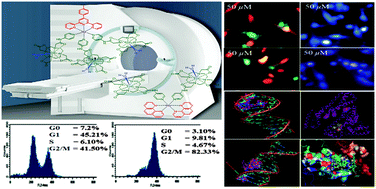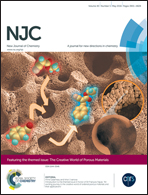Tri- and tetranuclear RuII–Gd III2 and RuII–Gd III3 d–f heterometallic complexes as potential bimodal imaging probes for MRI and optical imaging†
Abstract
The synthesis of tri- and tetranuclear RuII–GdIII2 and RuII–GdIII3 d–f heterometallic complexes of 4-aminopyridine-appended DO3A (DOTA-AMpy, 4) with 1,10-phenanthroline and 4′-(p-tolyl)-2,2′:6′,2′′-terpyridine ancillary ligands and their relaxometry and in vitro cytotoxicity studies are reported. Complexes [Ru(phen)2{Gd(DOTA-AMpy)(H2O)}2]Cl2 (7) and [Ru(ttpy){Gd(DOTA-AMpy)(H2O)}3]Cl2 (9) exhibit the “per Gd” longitudinal relaxivity of 6.19 and 7.47 mM−1 s−1 and 15.37 and 18.61 mM−1 s−1, respectively, in aqueous solution and in the presence of HSA (20 MHz, pH = 7.4, phosphate buffer saline, 37 °C). Complex 7 exhibits an emission band at 590 nm. The cell viability and cytotoxicity studies of complexes 7 and 9 against the HeLa cell lines by MTT assay demonstrate their cytotoxic activity with the IC50 values of 52.1 and 27.9 μM, respectively. Morphological assessment of apoptosis by acridine orange and ethidium bromide staining and by Hoechst-33342 assay shows marked morphological signs of apoptosis in a dose-dependent manner. Flow cytometric analysis by propidium iodide staining indicates the inhibition of HeLa cell proliferation and DNA ladder assay shows apoptotic cell death, lending support to the antitumor activity of 7 and 9. A molecular docking study reveals that these complexes intercalate with DNA and bind to HSA. Relaxometry and cytotoxicity studies indicate that complexes 7 and 9 could be used as potential bimodal imaging probes and as anticancer agents.


 Please wait while we load your content...
Please wait while we load your content...